When it comes to managing equipment, a big question is: How do we figure out when it might fail and what can we do to stop it? This is a key puzzle for folks in charge of keeping things running smoothly. The answer lies in something called the BathTub Reliability Curve.
BathTub Reliability Curve
The BathTub Reliability Curve, also known as the Bathtub Curve, is a graphical representation of the failure rate of a product over its life cycle. The curve takes its name from its shape, which resembles a traditional bathtub. It typically consists of three phases: the initial “infant mortality” phase, a long period of relatively low failure rates called the “useful life” phase, and finally, a phase of increasing failure rates known as the “wear-out” phase.
3 Phases of BathTub Curve
Knowing about the phases of the BathTub Reliability Curve allows asset managers to anticipate and plan for the varying failure patterns throughout an asset’s life cycle.
1. Infant Mortality Phase:
- This phase marks the initial period in the life cycle of equipment, where it is most susceptible to failures.
- Failures occurring during this phase are often attributed to manufacturing defects, design flaws, or inadequate quality control measures.
- Equipment may exhibit unexpected breakdowns or malfunctions shortly after installation or deployment.
- The failure rate during this phase is relatively high and may follow a random pattern, making it challenging to predict specific failure modes.
- Issues encountered in this phase typically require immediate attention and may necessitate repairs, replacements, or adjustments to rectify underlying defects and ensure optimal functionality.
Example of Infant Mortality Phase:
Consider a newly installed industrial pump in a manufacturing plant. Shortly after installation, the pump experiences frequent breakdowns due to defects in its components or improper assembly. These early failures disrupt production and necessitate immediate repairs or replacements.
2. Useful Life Phase:
- Following the infant mortality phase, the equipment enters a period characterized by a relatively low and stable failure rate.
- During this phase, the equipment operates reliably under normal operating conditions and with routine maintenance.
- Failures are infrequent, and the equipment demonstrates consistent performance, supporting uninterrupted operations.
- Maintenance activities such as preventive maintenance and periodic inspections are key to prolonging the useful life phase and maximizing equipment reliability.
- Proper maintenance practices help mitigate wear and tear, minimize the risk of unexpected failures, and ensure continued operational efficiency.
Example of Useful Life Phase:
Continuing with the industrial pump example, after addressing initial defects and undergoing necessary adjustments, the pump enters its useful life phase. With routine maintenance and proper operation, the pump operates smoothly, supporting continuous production without significant interruptions for an extended period.
3. Wear-Out Phase:
- As equipment approaches the latter stage of its life cycle, it enters the wear-out phase, marked by an increasing failure rate.
- Components within the equipment experience cumulative wear, aging, and deterioration, leading to a higher likelihood of failures.
- Despite diligent maintenance efforts, the frequency of failures gradually rises as the equipment nears the end of its operational lifespan.
- Common indicators of the wear-out phase include declining performance, increased maintenance requirements, and escalating repair costs.
- Organizations must closely monitor equipment health during this phase and consider strategic decisions regarding repair, replacement, or upgrades to minimize downtime and maintain operational continuity.
Example of Wear-Out Phase:
As the industrial pump approaches the end of its useful life, signs of wear and aging become more apparent. Despite diligent maintenance efforts, the pump starts experiencing increased instances of component failures, such as leaks, motor malfunctions, or bearing issues. Repair costs escalate, and downtime becomes more frequent, signaling that the pump is nearing the end of its operational viability.








